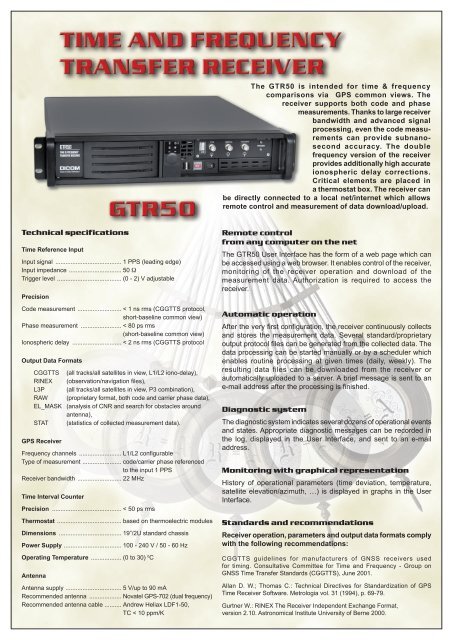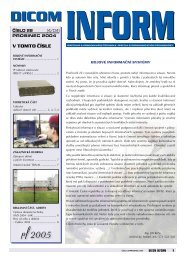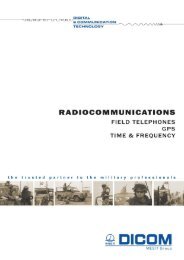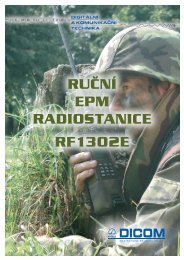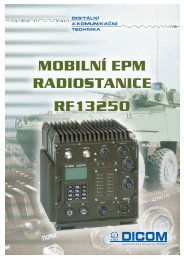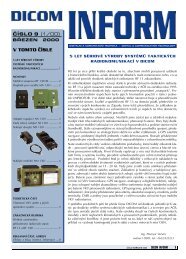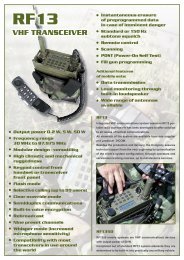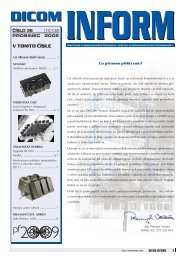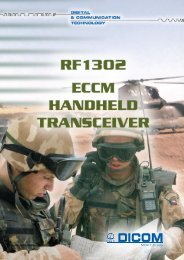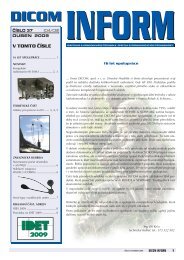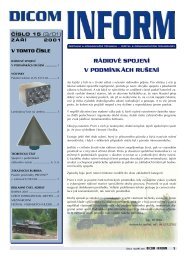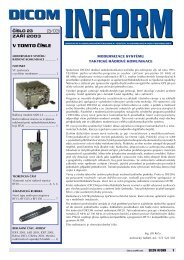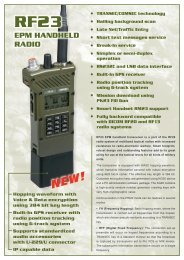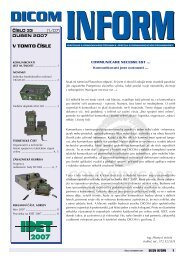CGGTTS Data - DICOM, spol. s ro
CGGTTS Data - DICOM, spol. s ro
CGGTTS Data - DICOM, spol. s ro
- No tags were found...
You also want an ePaper? Increase the reach of your titles
YUMPU automatically turns print PDFs into web optimized ePapers that Google loves.
The GTR50 is intended for time & frequencycomparisons via GPS common views. Thereceiver supports both code and phasemeasurements. Thanks to large receiverbandwidth and advanced signalp<strong>ro</strong>cessing, even the code measurementscan p<strong>ro</strong>vide subnanosecondaccuracy. The doublefrequency version of the receiverp<strong>ro</strong>vides additionally high accurateionospheric delay corrections.Critical elements are placed ina thermostat box. The receiver canbe directly connected to a local net/internet which allowsremote cont<strong>ro</strong>l and measurement of data download/upload.Technical specificationsTime Reference InputInput signal ........................................ 1 PPS (leading edge)Input impedance ............................... 50 WTrigger level ...................................... (0 - 2) V adjustablePrecisionCode measurement .......................... < 1 ns rms (<st<strong>ro</strong>ng>CGGTTS</st<strong>ro</strong>ng> p<strong>ro</strong>tocol,short-baseline common view)Phase measurement ......................... < 80 ps rms(short-baseline common view)Ionospheric delay .............................. < 2 ns rms (<st<strong>ro</strong>ng>CGGTTS</st<strong>ro</strong>ng> p<strong>ro</strong>tocolOutput <st<strong>ro</strong>ng>Data</st<strong>ro</strong>ng> Formats<st<strong>ro</strong>ng>CGGTTS</st<strong>ro</strong>ng> (all tracks/all satellites in view, L1/L2 iono-delay),RINEX (observation/navigation files),L3P (all tracks/all satellites in view, P3 combination),RAW (p<strong>ro</strong>prietary format, both code and carrier phase data),EL_MASK (analysis of CNR and search for obstacles a<strong>ro</strong>undantenna),STAT (statistics of collected measurement data).GPS ReceiverFrequency channels .......................... L1/L2 configurableType of measurement ....................... code/carrier phase referencedto the input 1 PPSReceiver bandwidth .......................... 22 MHzTime Interval CounterPrecision .......................................... < 50 ps rmsThermostat ...................................... based on thermoelectric modulesDimensions ...................................... 19”/2U standard chassisPower Supply .................................. 100 - 240 V / 50 - 60 HzOperating Temperature ................... (0 to 30) 0 CAntennaAntenna supply ................................. 5 V/up to 90 mARecommended antenna .................... Novatel GPS-702 (dual frequency)Recommended antenna cable .......... Andrew Heliax LDF1-50,TC < 10 ppm/KRemote cont<strong>ro</strong>lf<strong>ro</strong>m any computer on the netThe GTR50 User Interface has the form of a web page which canbe accessed using a web b<strong>ro</strong>wser. It enables cont<strong>ro</strong>l of the receiver,monitoring of the receiver operation and download of themeasurement data. Authorization is required to access thereceiver.Automatic operationAfter the very first configuration, the receiver continuously collectsand stores the measurement data. Several standard/p<strong>ro</strong>prietaryoutput p<strong>ro</strong>tocol files can be generated f<strong>ro</strong>m the collected data. Thedata p<strong>ro</strong>cessing can be started manually or by a scheduler whichenables <strong>ro</strong>utine p<strong>ro</strong>cessing at given times (daily, weekly). Theresulting data files can be downloaded f<strong>ro</strong>m the receiver orautomatically uploaded to a server. A brief message is sent to ane-mail address after the p<strong>ro</strong>cessing is finished.Diagnostic systemThe diagnostic system indicates several dozens of operational eventsand states. App<strong>ro</strong>priate diagnostic messages can be recorded inthe log, displayed in the User Interface, and sent to an e-mailaddress.Monitoring with graphical representationHistory of operational parameters (time deviation, temperature,satellite elevation/azimuth, …) is displayed in graphs in the UserInterface.Standards and recommendationsReceiver operation, parameters and output data formats complywith the following recommendations:<st<strong>ro</strong>ng>CGGTTS</st<strong>ro</strong>ng> guidelines for manufacturers of GNSS receivers usedfor timing. Consultative Committee for Time and Frequency - G<strong>ro</strong>up onGNSS Time Transfer Standards (<st<strong>ro</strong>ng>CGGTTS</st<strong>ro</strong>ng>), June 2001.Allan D. W.; Thomas C.: Technical Directives for Standardization of GPSTime Receiver Software. Met<strong>ro</strong>logia vol. 31 (1994), p. 69-79.Gurtner W.: RINEX The Receiver Independent Exchange Format,version 2.10. Ast<strong>ro</strong>nomical Institute University of Berne 2000.
Typical measurement results<st<strong>ro</strong>ng>CGGTTS</st<strong>ro</strong>ng> <st<strong>ro</strong>ng>Data</st<strong>ro</strong>ng>• commnon view based on <st<strong>ro</strong>ng>CGGTTS</st<strong>ro</strong>ng> data• Prague 2004-05-30/MJD53155• all tracks/all satellites in view• short-baseline (3 meters)• points represent tracks• colors represent satellite IDs• red line is average over visible satellitesCode Measurement <st<strong>ro</strong>ng>Data</st<strong>ro</strong>ng>• commnon view based on codemeasurement RAW data• Prague 2004-06-06/MJD53162• satellite PRN 27• 10 s sample period• short-baseline (3 meters)Phase Measurement <st<strong>ro</strong>ng>Data</st<strong>ro</strong>ng>• commnon view based on phasemeasurement RAW data• Prague 2004-06-06/MJD53162• satellite PRN 27• 10 s sample period• short-baseline (3 meters)<st<strong>ro</strong>ng>DICOM</st<strong>ro</strong>ng>, <st<strong>ro</strong>ng>spol</st<strong>ro</strong>ng>. s r. o., Sokolovská 573, 686 01 Uherské Hradiště, Czech Republic, Tel. +420 572 522 603, +420 572 801 603,Fax: +420 572 522 836, +420 572 801 836, E-mail: obo@dicom.mesit.cz, http://www.dicom.cz1204/01


